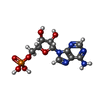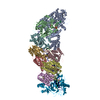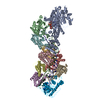+Search query
-Structure paper
| Title | Molecular basis for cA6 synthesis by a type III-A CRISPR-Cas enzyme and its conversion to cA4 production. |
|---|---|
| Journal, issue, pages | Nucleic Acids Res, Year 2024 |
| Publish date | Jul 11, 2024 |
 Authors Authors | Hemant N Goswami / Fozieh Ahmadizadeh / Bing Wang / Doreen Addo-Yobo / Yu Zhao / A Carl Whittington / Huan He / Michael P Terns / Hong Li /  |
| PubMed Abstract | The type III-A (Csm) CRISPR-Cas systems are multi-subunit and multipronged prokaryotic enzymes in guarding the hosts against viral invaders. Beyond cleaving activator RNA transcripts, Csm confers ...The type III-A (Csm) CRISPR-Cas systems are multi-subunit and multipronged prokaryotic enzymes in guarding the hosts against viral invaders. Beyond cleaving activator RNA transcripts, Csm confers two additional activities: shredding single-stranded DNA and synthesizing cyclic oligoadenylates (cOAs) by the Cas10 subunit. Known Cas10 enzymes exhibit a fascinating diversity in cOA production. Three major forms-cA3, cA4 and cA6have been identified, each with the potential to trigger unique downstream effects. Whereas the mechanism for cOA-dependent activation is well characterized, the molecular basis for synthesizing different cOA isoforms remains unclear. Here, we present structural characterization of a cA6-producing Csm complex during its activation by an activator RNA. Analysis of the captured intermediates of cA6 synthesis suggests a 3'-to-5' nucleotidyl transferring process. Three primary adenine binding sites can be identified along the chain elongation path, including a unique tyrosine-threonine dyad found only in the cA6-producing Cas10. Consistently, disrupting the tyrosine-threonine dyad specifically impaired cA6 production while promoting cA4 production. These findings suggest that Cas10 utilizes a unique enzymatic mechanism for forming the phosphodiester bond and has evolved distinct strategies to regulate the cOA chain length. |
 External links External links |  Nucleic Acids Res / Nucleic Acids Res /  PubMed:38989619 PubMed:38989619 |
| Methods | EM (single particle) |
| Resolution | 2.58 - 2.79 Å |
| Structure data | EMDB-43814, PDB-9ash: EMDB-43815, PDB-9asi: |
| Chemicals |  ChemComp-ATP:  ChemComp-MG:  ChemComp-HOH:  ChemComp-AMP: |
| Source |
|
 Keywords Keywords | RNA BINDING PROTEIN/RNA / Type III-A CRISPR-Cas / Csm / Cyclic Oligoadenylate synthesis / RNA BINDING PROTEIN-RNA complex |
 Movie
Movie Controller
Controller Structure viewers
Structure viewers About Yorodumi Papers
About Yorodumi Papers






 lactococcus lactis subsp. lactis (lactic acid bacteria)
lactococcus lactis subsp. lactis (lactic acid bacteria)